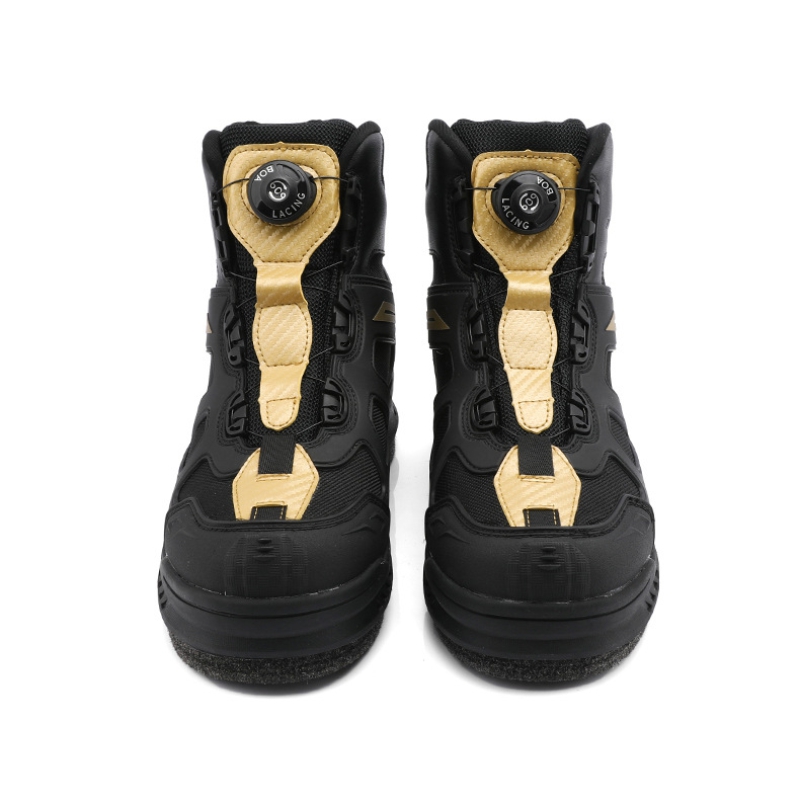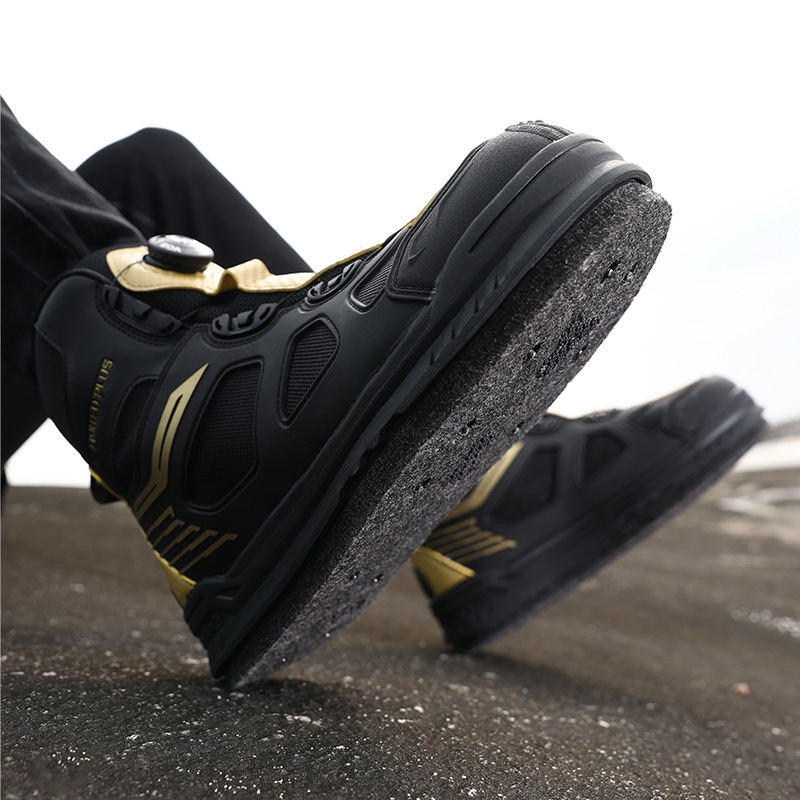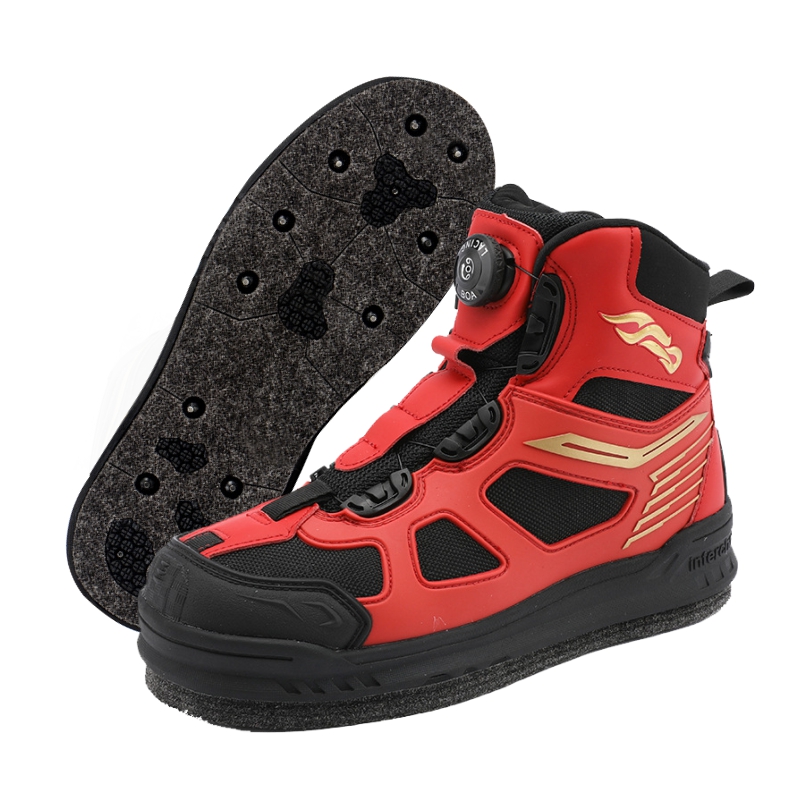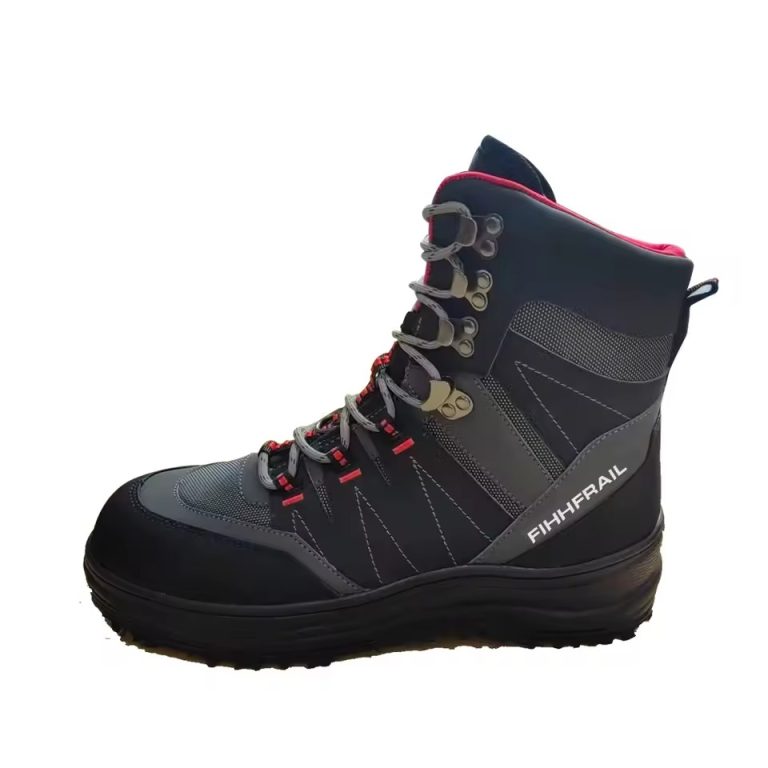The Importance of Waterproof Footwear in Fishing
Fishing often involves wading through water. Without waterproof footwear, you risk soaking your feet. Wet feet can lead to discomfort and even health issues. Such as blisters or athlete’s foot. Fish boots offer protection for your feet against these problems.

Fish boots also ensure better grip on slippery surfaces. This reduces the risk of accidents on wet boats decks or rocky shores. They keep you stable and secure while you cast your line or navigate tricky terrain. This is crucial for safety and performance.
Moreover, waterproof boots keep your feet warm. This is vital, especially in cold weather or when fishing in cold waters. Without proper insulation, exposure to cold can lead to problems. Like hypothermia and frostbite.
Lastly, waterproof fish boots add to your overall fishing experience. They allow you to focus on the joy of fishing without worrying about your feet. Comfortable, dry feet help you stay out longer and increase the chances of a good catch. This is why waterproof fish boots are essential for any fishing trip.
Top Features to Look for in Fish Boots
When choosing fish boots, many features ensure your comfort and protection. Look for these top features when selecting your next pair:
- Waterproofing: The main feature of fish boots is, of course, their ability to resist water. Ensure the boots are fully waterproof, not just water-resistant.
- Material: The durability of fish boots often comes down to the material. Rubber and neoprene are popular for their strong, long-lasting properties.
- Traction: Slip-resistant soles are a must. They provide stability on wet and slippery surfaces, a key element when fishing.
- Insulation: For cold water conditions, insulation is vital. It helps keep your feet warm, preventing conditions like frostbite.
- Comfort: Comfortable padding and supportive insoles make a big difference. They can help you withstand long hours on your feet.
- Breathability: While waterproofing is crucial, boots should also be breathable. This prevents sweat buildup, which can lead to discomfort.
- Height: Taller boots offer more protection against deep waters. However, the height should not restrict your mobility.
- Fit: A good fit is essential. Boots should allow room for thick socks while maintaining a snug fit to prevent blisters.
By keeping an eye out for these features, you can ensure that the fish boots you choose will serve you well on your fishing adventures.
How to Choose the Right Size and Fit
Choosing the right size and fit for your fish boots is crucial. Ill-fitting boots can lead to discomfort, hinder your movement, and even cause injuries. Here are some tips to help you find the perfect size and fit for your waterproof fish boots:
- Measure Correctly: Start by measuring your feet. Best do this at the end of the day when feet are largest. Use a ruler and measure both feet. Some people have one foot larger than the other. If so, choose the size that fits the larger foot.
- Check Size Charts: Different brands have different sizing. Always refer to the brand’s size chart before buying. It will help you match your foot measurement to the correct boot size.
- Try Them On: If possible, try on the boots with the socks you’ll wear while fishing. This ensures a true fit. Walk around to check for any tight spots or slippage.
- Room for Socks: Remember to allow room for thick, warm socks. They are a must in cold weather. But the boots should still fit snugly to avoid blisters.
- Ankle Support: Check for good ankle support, important when traversing uneven terrain. Make sure the boots are not too tight around your ankles.
- Toes Room: You should have enough room to wiggle your toes. But not so much that your feet slide forward in the boots.
- Test the Height: Taller boots offer more protection. But make sure you can move freely. Squat and bend in the boots to ensure you have enough flexibility.
- Secure Fitting: Lastly, the boots should feel secure on your feet. A loose fit can cause rubbing and lead to blisters. A secure fit will help maintain balance and stability.
By taking these steps, you can be confident that your fish boots will be comfortable. They should allow you to focus fully on your fishing activities without foot troubles.
The Best Materials for Durability and Comfort
When selecting fish boots, the choice of material is crucial. Two factors stand out—durability and comfort. Here are the best materials that meet both these needs:
- Rubber: Rubber is a classic choice for fish boots. It’s tough and 100% waterproof. Rubber boots last long, even in harsh conditions.
- Neoprene: Neoprene is flexible and provides excellent insulation. It keeps feet warm and dry. This material also adds to the boot’s comfort.
- PVC: Polyvinyl Chloride, or PVC, is lighter than rubber. It’s waterproof and suitable for less rugged conditions. PVC boots offer a balance of durability and ease of movement.
- Leather: Leather is a premium option. When treated, it becomes water-resistant. Leather boots are known for their durability and style.
- Nylon: Nylon is often used with other materials. It adds breathability to the boots. Nylon panels in fish boots help reduce sweating and discomfort.
- Combination Materials: Some fish boots combine materials. For example, rubber and neoprene together improve durability and comfort. Combination boots offer the best of both worlds.
Each material has its own set of benefits. Consider where and how you plan to use your fish boots. This will guide you in choosing the material best suited for your needs.

Maintenance and Care for Your Fish Boots
Proper maintenance and care for your fish boots extend their life and performance. Here’s how to keep your boots in top condition:
- Clean Regularly: After each use, rinse your boots with fresh water. This prevents salt and dirt build-up, which can degrade materials.
- Dry Properly: Air dry your boots away from direct heat sources. Direct heat can damage the material, especially rubber and neoprene.
- Store Correctly: Keep your boots in a cool, dry place. Avoid folding or compressing them, as this can cause cracks or creases over time.
- Condition Leather: For leather boots, use a leather conditioner. This keeps the leather supple and water-resistant.
- Check for Wear: Regularly inspect your boots for signs of wear or tear. Early detection of damage can mean simple repairs rather than full replacement.
- Remove Odors: To tackle odors, sprinkle baking soda inside the boots overnight. Then, shake it out before wearing them again.
- Use Protective Sprays: There are sprays available that add an extra layer of waterproofing and protection. Consider using them, especially if you frequently fish in harsh conditions.
By following these simple care tips, your fish boots will be ready for many fishing adventures to come. It’s all about giving your gear the same respect you give to the sport of fishing itself.
The Top Brands for Waterproof Fish Boots
When you’re in the market for waterproof fish boots, choosing a reliable brand is crucial. Here are some of the top brands that stand out for their quality and innovation:
- XTRATUF: They offer a range of durable fish boots, prized for their slip-resistant soles and extreme comfort.
- Hodgman: Known for their high-quality waders and boots, Hodgman provides excellent waterproofing and fit.
- Caddis: Caddis boots are widely respected for their breathability and lightweight design.
- Bogs: Bogs boots are not only waterproof but also come with unique insulation properties, ideal for colder climates.
- Simms: A go-to brand for professional anglers, Simms boots boast superior traction and durability.
- Muck Boot: With a focus on comfort, The Original Muck Boot Company offers boots that are both sturdy and comfortable for long days of fishing.
When browsing these brands, remember to check for the essential features previously discussed, like material, traction, and comfort. Always ensure you’re investing in a pair of fish boots that will hold up against the challenging conditions you’ll face while fishing. Quality fish boots are an investment in your safety and enjoyment on the water.
Price Range and Where to Buy
When shopping for quality fish boots, the price can vary significantly. The cost depends on factors like brand, materials, and features. Generally, you can expect to pay anywhere from $50 for basic models to over $200 for premium ones.
To find the right pair of fish boots within your budget, consider these options:
- Outdoor Sporting Goods Stores: These stores often have a wide selection of fish boots. Staff can also help with fittings and offer advice based on experience.
- Online Retailers: Websites can offer competitive pricing and a variety of brands. Be sure to check size charts and return policies when ordering online.
- Fishing Specialty Shops: These shops may have higher prices, but they offer expert knowledge. They can help ensure you get the best fit and functionality for your needs.
- Second-Hand Stores: For those on a tight budget, gently used boots can be a great find. Check local listings or online marketplaces for deals.
- Brand Outlets: Buying directly from the brand’s outlet or website may offer exclusive models or discounts.
- Seasonal Sales: Keep an eye out for end-of-season sales or holiday discounts. These can be excellent times to purchase high-quality fish boots at a lower price.
Remember, the cheapest option is not always the best value. Invest in a pair of fish boots that offer the protection and comfort you need for a successful fishing experience.
Essential Accessories for Your Fishing Boots
Beyond finding the perfect pair of waterproof fish boots, it’s wise to equip them with the right accessories. Doing so can elevate your comfort and extend the life of your boots. Here are some essential accessories for your fishing boots:
- Boot Liners: Add an extra layer of insulation. They keep feet warm in cold conditions. Choose liners that wick away moisture.
- Insoles: Upgrade your comfort with quality insoles. They provide additional arch support. This helps to reduce foot fatigue during long fishing trips.
- Boot Dryer: A boot dryer is a handy tool to quickly dry boots. It prevents the growth of bacteria and odor. It’s especially useful if you fish often.
- Boot Brush: Keep a brush handy to clean off mud and debris. This will help you maintain the boots’ appearance and functionality.
- Waders: Waders keep you dry when you step deeper into water. They work in tandem with your boots to protect your lower body.
- Boot Hanger: A hanger allows you to store your boots properly. It helps boots retain their shape and dry out evenly.
- Waterproof Socks: Although your boots are waterproof, waterproof socks add another defense layer. They protect in case water gets into your boots.
- Repair Kit: Accidents happen. A repair kit can fix minor damage on the go. This avoids worsening the damage.
By adding these accessories to your fishing gear, you can ensure a comfortable, efficient, and long-lasting fishing experience. Make sure to incorporate your fish boots into the equation when planning your next fishing adventure.


